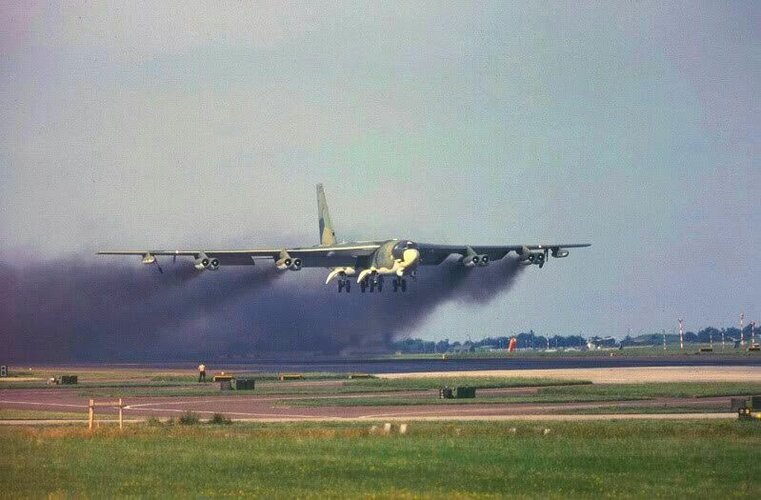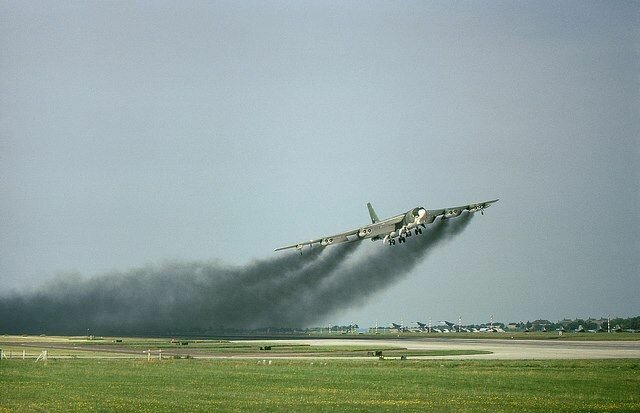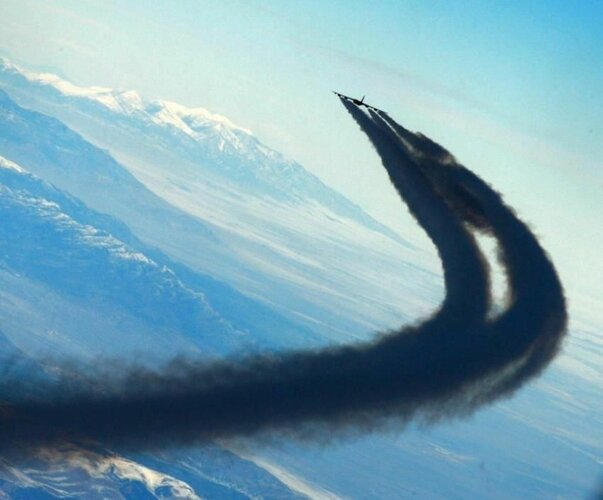Indeed, but not the right color, smell from the old TF-33's...Well, you could start a pickled engine without telling the tower...
You are using an out of date browser. It may not display this or other websites correctly.
You should upgrade or use an alternative browser.
You should upgrade or use an alternative browser.
Boeing B-52J / B-52 Re-Engining
- Joined
- 19 February 2007
- Messages
- 1,432
- Reaction score
- 2,665
Essence de Walnut Shell?Indeed, but not the right color, smell from the old TF-33's...
FighterJock
ACCESS: Above Top Secret
- Joined
- 29 October 2007
- Messages
- 5,564
- Reaction score
- 5,868
I can remember seeing the B-52H performing at RAF Luechars airshow many years ago and wondering about all the smoke that came from the engines, that was a characteristic part of early B-52s with the TF-33 engines and it left an impression on me and one that has not left after all those years.
More like partially combusted JP-8Essence de Walnut Shell?
FighterJock
ACCESS: Above Top Secret
- Joined
- 29 October 2007
- Messages
- 5,564
- Reaction score
- 5,868
I had always wondered about what the cause was about the excess smoke from the B-52 TF-33 engines, now I know that it was partially combusted JP-8. At least the new engines won't have that problem they will burn 100% of the fuel leaving no smoke trail at the back.
- Joined
- 15 January 2021
- Messages
- 392
- Reaction score
- 1,430
Early jet engine combustors tended to run with a rich fuel / air ratio in the front end combustor before being diluted with additional cooling air towards the rear before reaching the turbine inlet. The overall fuel / air ratio is lean of stoichiometric, but the localized rich area would generate soot particles that passed through the turbine and seen as exhaust smoke. 99+% of the fuel was burned, but you still got soot formation.
The rich front end was to enhance cold start and altitude restart capability to meet specifications for those characteristics. Better design tools and understanding of combustion flows inside the combustor allowed for leaner burning front ends, resulting in the current “smokeless” designs.
The rich front end was to enhance cold start and altitude restart capability to meet specifications for those characteristics. Better design tools and understanding of combustion flows inside the combustor allowed for leaner burning front ends, resulting in the current “smokeless” designs.
FighterJock
ACCESS: Above Top Secret
- Joined
- 29 October 2007
- Messages
- 5,564
- Reaction score
- 5,868
I did not realise that the early turbojet B-52 also used water injection? Was that to increase thrust?
- Joined
- 15 January 2021
- Messages
- 392
- Reaction score
- 1,430
Water injection cools the compressor discharge air and increases its density, as well as increasing mass flow, allowing more fuel to be burned before reaching the turbine temperature limits and increasing thrust. More fuel means a higher Fuel / Air ratio (i.e. richer), which makes the soot formation even worse than before, making a smokey engine worse with water injection.
Last edited:
FighterJock
ACCESS: Above Top Secret
- Joined
- 29 October 2007
- Messages
- 5,564
- Reaction score
- 5,868
So in other words it was a double edged sword, increase the thrust but also increase the smoke. Something that the USAF will be glad to get rid of after all those years with the new smoke free and more powerful engines.
- Joined
- 15 January 2021
- Messages
- 392
- Reaction score
- 1,430
Water injection thrust augmentation was used only on takeoff where the J57 powered B-52 and KC-135 were thrust challenged, so the really heavy smoke was only an issue around the runway. But any smoke trail is a high visibility arrow in the sky that makes the aircraft easy to locate for an adversary.
FighterJock
ACCESS: Above Top Secret
- Joined
- 29 October 2007
- Messages
- 5,564
- Reaction score
- 5,868
So no more nasty smoke trails in the Sky to alert the potential enemy to where the B-52s are coming from that is another plus point.
- Joined
- 15 January 2021
- Messages
- 392
- Reaction score
- 1,430
True, but the TF33 engines on the B-52H were pretty good in regards to smoke. Of course, contrails when operating at altitude is another operational consideration, for any fuel burning engine.So no more nasty smoke trails in the Sky to alert the potential enemy to where the B-52s are coming from that is another plus point.
BlackBat242
OK, I changed my personal text ;)
- Joined
- 10 April 2013
- Messages
- 1,449
- Reaction score
- 4,160
That last one has to be a weird camera angle on a contrail or a chase/follower at a very interesting angel. Most water injection systems have a drain feature when cabin pressurization starts because the water will freeze and break stuff.
- Joined
- 3 June 2011
- Messages
- 18,293
- Reaction score
- 12,099
The J75 in the F-105 had it too.Water injection thrust augmentation was used only on takeoff where the J57 powered B-52 and KC-135 were thrust challenged, so the really heavy smoke was only an issue around the runway. But any smoke trail is a high visibility arrow in the sky that makes the aircraft easy to locate for an adversary.
Yep, there were stories about the guys in Vietnam who didn't to fly a mission who would "accidentally" hit the cabin pressurization taxiing to the active and empty the water tank, be too heavily loaded to take off without the water, and "have" to abort.The J75 in the F-105 had it too.
Scott Kenny
ACCESS: USAP
- Joined
- 15 May 2023
- Messages
- 11,258
- Reaction score
- 13,697
"We burned down the Kremlin house, it died with an awful flash...""smoke on the bomber / and fire in the sky " LMAO
Yes. Cooler air into the turbines which allows more fuel to be burned, more mass flow from the fuel and the water. It's an old Jet trick, works well but causes incomplete combustion = lots of smoke.I did not realise that the early turbojet B-52 also used water injection? Was that to increase thrust?
BlackBat242
OK, I changed my personal text ;)
- Joined
- 10 April 2013
- Messages
- 1,449
- Reaction score
- 4,160
As well as a number of other aircraft with engines designed in the late 1940s - early 1950s.The J75 in the F-105 had it too.
Just a quick glance finds:
J33 (RF-80/F-80, F9F, F-94)
J42 (F9F)
J47 (B-45A/C & B-47E)
J48 (F9F)
Last edited:
Scott Kenny
ACCESS: USAP
- Joined
- 15 May 2023
- Messages
- 11,258
- Reaction score
- 13,697
Even the Pegasus engine in Harriers used water injection.As well as a number of other aircraft with engines designed in the late 1940s - early 1950s.
Just a quick glance finds:
J33 (RF-80/F-80, F9F, F-94)
J42 (F9F)
J47 (B-45A/C & B-47E)
J48 (F9F)
Forest Green
ACCESS: Above Top Secret
- Joined
- 11 June 2019
- Messages
- 9,365
- Reaction score
- 17,051
Scott Kenny
ACCESS: USAP
- Joined
- 15 May 2023
- Messages
- 11,258
- Reaction score
- 13,697
It's just not right...Sonuva... smokeless B-52's!?
FighterJock
ACCESS: Above Top Secret
- Joined
- 29 October 2007
- Messages
- 5,564
- Reaction score
- 5,868
But potential enemy's won't see the B-52Js coming, I think that was the whole point of the new engines Scott Kenny.
BlackBat242
OK, I changed my personal text ;)
- Joined
- 10 April 2013
- Messages
- 1,449
- Reaction score
- 4,160
But potential enemy's won't see the B-52Js coming, I think that was the whole point of the new engines Scott Kenny.
The point of the new engines is that the TF33s were ancient, no parts were being made any more, and they are close to running out of the spare parts cache* they got when the C-141s (which also used TF33s) were retired in favor of the C-17s.
This gets them new engines with far lower maintenance needs (lower failure rate and fewer parts per engine), an active production line for both engines and parts, and lower fuel use for the same thrust.
In the 1990s - early 2000s the USAF was wanting to replace the engines for the same reasons, but the retirement of the C-141s gave the B-52H fleet a bunch of new parts etc. The two models of the engines (-3 for B-52H and -7 or -7A for the C-141) were different in some details, but many parts were interchangeable, thus easing the strain on the supply situation.
FighterJock
ACCESS: Above Top Secret
- Joined
- 29 October 2007
- Messages
- 5,564
- Reaction score
- 5,868
Thanks BlackBat242, I am surprised that the USAF stuck with the TF33s for so long. I know that they tried to get them replaced with newer engines back in the early 2000s but that program fell through for some reason that I have forgotten.
Thanks BlackBat242, I am surprised that the USAF stuck with the TF33s for so long. I know that they tried to get them replaced with newer engines back in the early 2000s but that program fell through for some reason that I have forgotten.
The problem was always up front cost when so many engines and parts were available combined with the complications of a four engine conversion (almost impossible for asymmetric thrust in an engine out scenario). As @BlackBat242 notes, exhaustion of the TF33 supply was the motivation.
Forest Green
ACCESS: Above Top Secret
- Joined
- 11 June 2019
- Messages
- 9,365
- Reaction score
- 17,051

Pentagon weapons tester highlights delays for B-52, 3DELRR radars - Breaking Defense
Key schedule dates to integrate a new radar into the Air Force’s B-52 fleet could be delayed by as much as a year, and a separate effort to deploy a ground-based radar is also experiencing schedule slips, the Pentagon’s top weapons tester found in a new report.
OliverSedlacek
ACCESS: Confidential
- Joined
- 31 March 2022
- Messages
- 139
- Reaction score
- 160
IMO a one year delay isn't too bad.
it won't be a YB-52J.I'm wondering when the first YB-52J prototype will fly?
Not earlier than late 2028.
Three years time? Why so long?
New engines and new avionics is a 2-3 yearlong DT/OT effort. When they completely ripped out the old computers and spin jens for AMI that combined program took about 2 years. I showed up to the CTF just at the tail end of AMI in 2005. The other thing that they do is plan a pause in the middle to incorporate any urgent fixes identified in the first part of testing. Oh, new engines mean P&FQ tests in addition to all of the avionics stuff, then you have to rewrite the -1 with all the new systems and performance numbers, verified through flight test.Three years time? Why so long?
Scott Kenny
ACCESS: USAP
- Joined
- 15 May 2023
- Messages
- 11,258
- Reaction score
- 13,697
Rewriting the -1 alone is likely a year-long process. Maybe a year and a half to two years to include verification.New engines and new avionics is a 2-3 yearlong DT/OT effort. When they completely ripped out the old computers and spin jens for AMI that combined program took about 2 years. I showed up to the CTF just at the tail end of AMI in 2005. The other thing that they do is plan a pause in the middle to incorporate any urgent fixes identified in the first part of testing. Oh, new engines mean P&FQ tests in addition to all of the avionics stuff, then you have to rewrite the -1 with all the new systems and performance numbers, verified through flight test.
Similar threads
-
USAF to Retire B-1, B-2 in Early 2030s as B-21 Comes On-Line
- Started by flateric
- Replies: 323
-
-
-
-




